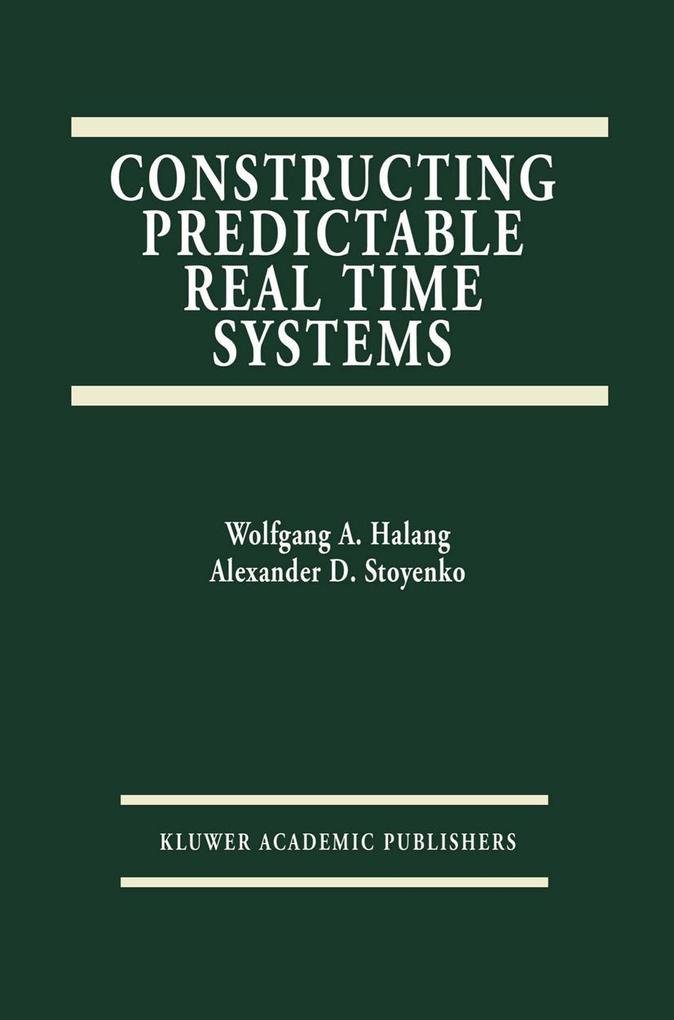1 Introduction.- 1.1 Motivation.- 1.2 Predictability and Simplicity.- 1.3 Constructing Predictable Real Time SystemsNew Thinking Categories and Optimality Criteria.- 1.4 Guiding Principles for Predictable, Verifiable Real Time Software and Hardware.- 1.5 Book Outline.- 2 Real Time Features of High Level Languages.- 2.1 A Representative Real Time Application Design.- 2.2 Historical Development of Real Time Languages.- 2.3 Requirements of a Real Time Language.- 2.4 Review of Existing Languages.- 2.5 Taking a Closer Look at Real-Time Euclid.- 2.6 A Second Review - Focusing on Real Time Features.- 2.7 Taking a Closer Look at Ada.- 2.8 Taking a Closer Look at PEARL.- 2.9 Proposal for an Extension of PEARL.- 3 Language-Independent Schedulability Analysis of Real Time Programs.- 3.1 Front End of the Schedulability Analyser.- 3.2 Back End of the Schedulability Analyser.- 3.3 Schedulability Analysis of Real-Time Euclid and Ex-tended PEARL.- 3.4 Summary.- 4 A Real Time Hardware Architecture.- 4.1 Useful Analogies.- 4.2 Properties and Architectural Implications of Comprehen-sive Deadline-Driven Scheduling.- 4.3 The Layered Structure of Real Time Operating Systems.- 4.4 Outline of the Architecture.- 4.5 Comparison with other Architectures.- 4.6 Task-Oriented and Predictable Storage Management.- 4.7 Direct Memory Access Without Cycle Stealing.- 4.8 Precisely Timed Peripherals.- 4.9 Summary.- 5 An Operating System Kernel and its Dedicated Processor.- 5.1 Hardware Organisation.- 5.2 Primary Event Reaction.- 5.3 Secondary Event Reaction.- 5.4 Summary.- 6 Implementation.- 6.1 Real-Time Euclid.- 6.2 Extended PEARL.- 6.3 Summary.- 7 Evaluation.- 7.1 Real-Time Euclid and its Schedulability Analyser.- 7.2 Qualitative Evaluation of the Co-processor Architecture..- 7.3 Summary.- 8 Outlook.-8.1 Summary of Contributions.- 8.2 Directions for Future Research.
Inhaltsverzeichnis
1 Introduction. - 1. 1 Motivation. - 1. 2 Predictability and Simplicity. - 1. 3 Constructing Predictable Real Time SystemsNew Thinking Categories and Optimality Criteria. - 1. 4 Guiding Principles for Predictable, Verifiable Real Time Software and Hardware. - 1. 5 Book Outline. - 2 Real Time Features of High Level Languages. - 2. 1 A Representative Real Time Application Design. - 2. 2 Historical Development of Real Time Languages. - 2. 3 Requirements of a Real Time Language. - 2. 4 Review of Existing Languages. - 2. 5 Taking a Closer Look at Real-Time Euclid. - 2. 6 A Second Review Focusing on Real Time Features. - 2. 7 Taking a Closer Look at Ada. - 2. 8 Taking a Closer Look at PEARL. - 2. 9 Proposal for an Extension of PEARL. - 3 Language-Independent Schedulability Analysis of Real Time Programs. - 3. 1 Front End of the Schedulability Analyser. - 3. 2 Back End of the Schedulability Analyser. - 3. 3 Schedulability Analysis of Real-Time Euclid and Ex-tended PEARL. - 3. 4 Summary. - 4 A Real Time Hardware Architecture. - 4. 1 Useful Analogies. - 4. 2 Properties and Architectural Implications of Comprehen-sive Deadline-Driven Scheduling. - 4. 3 The Layered Structure of Real Time Operating Systems. - 4. 4 Outline of the Architecture. - 4. 5 Comparison with other Architectures. - 4. 6 Task-Oriented and Predictable Storage Management. - 4. 7 Direct Memory Access Without Cycle Stealing. - 4. 8 Precisely Timed Peripherals. - 4. 9 Summary. - 5 An Operating System Kernel and its Dedicated Processor. - 5. 1 Hardware Organisation. - 5. 2 Primary Event Reaction. - 5. 3 Secondary Event Reaction. - 5. 4 Summary. - 6 Implementation. - 6. 1 Real-Time Euclid. - 6. 2 Extended PEARL. - 6. 3 Summary. - 7 Evaluation. - 7. 1 Real-Time Euclid and its Schedulability Analyser. - 7. 2 Qualitative Evaluation of the Co-processor Architecture. . - 7. 3 Summary. - 8 Outlook. -8. 1 Summary of Contributions. - 8. 2 Directions for Future Research.
